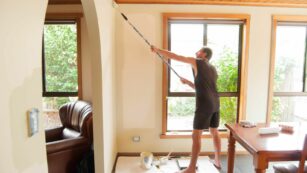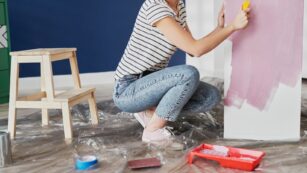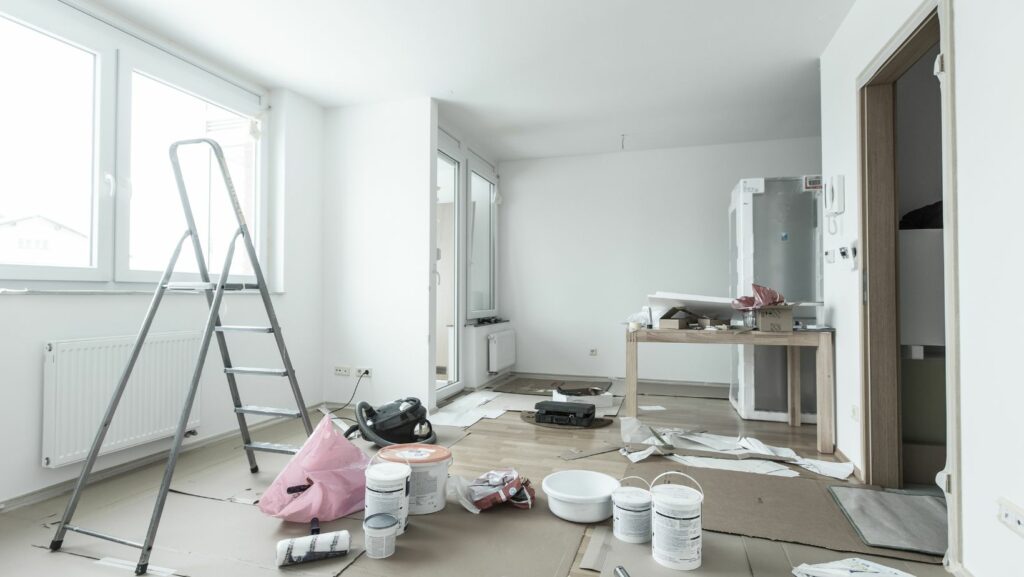Transforming a room doesn’t always require a complete overhaul. Sometimes, all it takes is a fresh coat of paint and a bit of creativity. DIY wall painting offers an affordable and fun way to revamp any space, allowing personal style to shine through. With endless possibilities, from bold geometric patterns to subtle ombre effects, there’s something for every taste and skill level.
DIY Wall Painting Ideas
Geometric Patterns
Geometric patterns add a modern touch. Use painter’s tape to create clean lines and sharp edges. Triangles, diamonds, and chevrons are popular choices. Alternate between bright and neutral colors for a balanced look. For example, a monochrome palette with varying shades of gray can make a striking impact on any wall.
Ombre Effects
 Ombre effects offer a subtle, gradient transition. Blend two or more colors, moving from dark to light. Start with a bold color at the base, gradually lightening as you move upwards. Consider using a sponge or large brush for a seamless blend. A blue-to-white ombre creates a serene, coastal vibe.
Ombre effects offer a subtle, gradient transition. Blend two or more colors, moving from dark to light. Start with a bold color at the base, gradually lightening as you move upwards. Consider using a sponge or large brush for a seamless blend. A blue-to-white ombre creates a serene, coastal vibe.
Stencils and decals simplify intricate designs. Choose from floral patterns, abstract shapes, or custom designs. Position the stencil on the wall, then apply paint over it. This technique allows for detailed artwork without the complexity of freehand painting. Gold leaf stencils can add an elegant touch.
Accent Walls
Accent walls serve as focal points. Select a single wall and paint it in a bold color or pattern. This draws attention and breaks the monotony of uniform walls. An accent wall behind a headboard or in the living room creates a dramatic effect. Deep blues, rich reds, and even blacks can serve as excellent choices.
Chalkboard Paint
Chalkboard paint turns walls into interactive spaces. Apply the paint on a child’s bedroom wall, kitchen, or home office. Use it to jot down notes, draw, or plan. This versatile solution adds both functionality and fun. Black chalkboard paint fits modern decor, while colored versions offer variety.
Stripes and Textured Finishes
 Stripes add a classic, timeless look. Horizontal stripes make a room feel wider, while vertical ones add height. Use a level and painter’s tape for precision. Alternate between two or three colors. A combination of pastel and bold colors in vertical stripes can refresh a living space.
Stripes add a classic, timeless look. Horizontal stripes make a room feel wider, while vertical ones add height. Use a level and painter’s tape for precision. Alternate between two or three colors. A combination of pastel and bold colors in vertical stripes can refresh a living space.
Textured finishes give walls a tactile dimension. Techniques like sponging, rag rolling, and combing create various effects. Use specialized brushes or tools to apply texture. For instance, a rag rolling technique with a warm color palette enhances a cozy ambiance in any room.
Murals
Murals transform walls into artworks. Plan a large-scale image or scene. While complex designs might require professional help, simpler images can be DIY projects. A nature-themed mural in a bathroom or a night sky scene in a bedroom adds personality and uniqueness.
Color Blocking
Color blocking involves contrasting colors in larger sections. Choose complementary or opposing colors for distinct zones on a wall. This technique breaks the monotony of plain walls and adds a contemporary feel. For example, a combination of mustard yellow and deep teal can create a vibrant space.
Basic Tools And Materials
Every DIY wall painting project requires the right tools and materials for a smooth and professional finish. Here are the essential items you need:
Essential Painting Supplies
-
 Paint Brushes: Various sizes for different areas and edges
Paint Brushes: Various sizes for different areas and edges -
Roller Brushes: Ideal for covering large surfaces quickly
-
Painter’s Tape: Creates clean lines and protects areas not to be painted
-
Drop Cloths: Protect floors and furniture from paint spills
-
Paint Trays: Hold and distribute paint for rollers
-
Sandpaper: Prepares surfaces by smoothing out rough areas
-
Putty Knife: Applies filler to holes and imperfections
-
Spackle or Filler: Fills holes and cracks in the wall
-
Ladder: Reaches higher areas safely
-
Stir Sticks: Ensures paint is well mixed before application
Choosing The Right Paint
Selecting the appropriate paint type and finish is crucial for achieving the desired effect:
-
Interior vs. Exterior Paint: Choose based on whether the surface is indoors or outdoors
-
Water-based vs. Oil-based Paint: Water-based is easier to clean; oil-based offers durability
-
Finish (e.g., Matte, Satin, Gloss): Matte hides imperfections; satin offers mild sheen; gloss is highly reflective and durable

